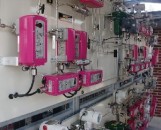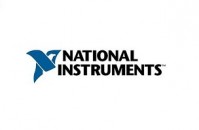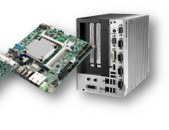 Manufacturers and equipment builders are looking for ways to simplify and standardize safety across their machines and systems. With the new Allen-Bradley Compact GuardLogix 5370 controller from Rockwell Automation, users no longer need separate networks and controllers for safety and motion in applications with up to 16 axes. This makes it easier to design safety into a wide range of standard and custom machines, and results in simpler system architectures.
Manufacturers and equipment builders are looking for ways to simplify and standardize safety across their machines and systems. With the new Allen-Bradley Compact GuardLogix 5370 controller from Rockwell Automation, users no longer need separate networks and controllers for safety and motion in applications with up to 16 axes. This makes it easier to design safety into a wide range of standard and custom machines, and results in simpler system architectures.
“The new Compact GuardLogix 5370 controller has all the performance capabilities of our popular Allen-Bradley CompactLogix 5370 controller, while also providing integrated safety and motion on a single EtherNet/IP network,” said Ming Jing Ye, global product manager, Rockwell Automation. “When safety, motion and standard control are combined into one package, configuration is easier, wiring is reduced and users get better diagnostics. Ultimately, it helps increase machine uptime and plant productivity.”
The Compact GuardLogix 5370 controller also helps users meet global safety standards. It achieves Safety Integrity Level 3, Performance Level e and Category 4 – the highest ratings for machine safety. When used in combination with the Allen-Bradley Kinetix 5500 servo drive or the Allen-Bradley PowerFlex 527 AC drive, users have integrated safe torque off on EtherNet/IP.
As with other Logix controllers, engineers use the Rockwell Software Studio 5000 software to configure the Compact GuardLogix 5370 controller and develop all elements of their control system. Data can be defined once, and then easily accessed and re-used across different machine types to speed system development and commissioning.
In addition, a single programming environment for both safety and standard control removes the need to manually manage separate standard and safety memory, or partition logic to isolate safety.
The Compact GuardLogix 5370 controller, being manufactured in Singapore, also includes dual Ethernet ports to support both linear and device-level-ring (DLR) network topologies. Built-in energy storage removes the need for batteries, and a removable 1-GB Secure Digital (SD) card improves data integrity.
Rockwell Automation also will be releasing an on-machine option later this year – the Allen-Bradley Armor Compact GuardLogix 5370 controller. This option allows users to place the controller closer to the application or onto the machine, which eases installation, commissioning and troubleshooting. The on-machine controller is IP67-rated for wash-down protection and includes quick-connect cabling to ease system wiring.
- See more at: http://phx.corporate-ir.net/phoenix.zhtml?c=196186&p=RssLanding&cat=news&id=2142779#sthash.m0ljpbRN.dpuf

 Rotork Schischek compact explosionproof valve actuators have been selected as the reliable solution for a critical petrochemical analysis process. Ecopetrol is the largest petroleum company in Colombia, engaged in oil and gas exploration, production and refining. The company uses Near Infrared Spectroscopy (NIR) to perform quantitative sampling separation of hydrocarbons. The process separates the hydrocarbons into four chemical groups – alkanes, aromatics, resins and asphaltenes.
Rotork Schischek compact explosionproof valve actuators have been selected as the reliable solution for a critical petrochemical analysis process. Ecopetrol is the largest petroleum company in Colombia, engaged in oil and gas exploration, production and refining. The company uses Near Infrared Spectroscopy (NIR) to perform quantitative sampling separation of hydrocarbons. The process separates the hydrocarbons into four chemical groups – alkanes, aromatics, resins and asphaltenes. National Instruments, the provider of platform-based systems that enable engineers and scientists to solve the world’s greatest engineering challenges, announced today a collaboration with the Industrial Internet Consortium (IIC) and industry leaders Bosch Rexroth, Cisco, Intel, KUKA, Schneider Electric and TTTech to develop the world’s first Time Sensitive Networking (TSN) testbed. These organizations aim to advance the network infrastructure to support the future of the Industrial Internet of Things (IIoT) and Industry 4.0. To support new digital capabilities, connected manufacturing, designers and users need more reliable and secure access to smart edge devices. Standard network technologies must evolve to meet the demanding requirements of these next-generation industrial systems and improve the way we operate our machines, electrical grids and transportation systems.
National Instruments, the provider of platform-based systems that enable engineers and scientists to solve the world’s greatest engineering challenges, announced today a collaboration with the Industrial Internet Consortium (IIC) and industry leaders Bosch Rexroth, Cisco, Intel, KUKA, Schneider Electric and TTTech to develop the world’s first Time Sensitive Networking (TSN) testbed. These organizations aim to advance the network infrastructure to support the future of the Industrial Internet of Things (IIoT) and Industry 4.0. To support new digital capabilities, connected manufacturing, designers and users need more reliable and secure access to smart edge devices. Standard network technologies must evolve to meet the demanding requirements of these next-generation industrial systems and improve the way we operate our machines, electrical grids and transportation systems. exida invites you to attend a complimentary training on the exSILentia® Safety Lifecycle tool. Attendees will learn how to perform Safety Integrity Level (SIL) Selection and Verification using the advanced capabilities of exSILentia® . This will help users determine the required risk reduction for each hazard scenario and the achieved risk reduction for each identified Safety Instrumented Function (SIF). The class will also cover interfacing with Process Hazard Analysis (PHA) results, documentation of the Safety Requirements Specification (SRS), and operational aspects such as proof testing.
exida invites you to attend a complimentary training on the exSILentia® Safety Lifecycle tool. Attendees will learn how to perform Safety Integrity Level (SIL) Selection and Verification using the advanced capabilities of exSILentia® . This will help users determine the required risk reduction for each hazard scenario and the achieved risk reduction for each identified Safety Instrumented Function (SIF). The class will also cover interfacing with Process Hazard Analysis (PHA) results, documentation of the Safety Requirements Specification (SRS), and operational aspects such as proof testing. Honeywell and Palo Alto Networks® are collaborating to boost the cyber security capabilities of control systems used by industrial facilities and critical infrastructure. Honeywell's Industrial Cyber Security business is now offering the Palo Alto Networks Next-Generation Security Platform to industrial customers. The collaboration enables customers to better prevent cyber attacks against their Process Control Networks (PCN) and Operational Technology (OT) environments in order to protect their assets and maximize production uptime and safety.
Honeywell and Palo Alto Networks® are collaborating to boost the cyber security capabilities of control systems used by industrial facilities and critical infrastructure. Honeywell's Industrial Cyber Security business is now offering the Palo Alto Networks Next-Generation Security Platform to industrial customers. The collaboration enables customers to better prevent cyber attacks against their Process Control Networks (PCN) and Operational Technology (OT) environments in order to protect their assets and maximize production uptime and safety. Yokogawa Electric Corporation announces the release of version R3.30 of its Plant Resource Manager (PRM®) software tool for the centralized management of large amounts of data from plant monitoring and control devices and manufacturing equipment. PRM R3.30 is an upgrade to R3.20 and includes an improved management function for HART®* and enhancements to the navigation function. With this new PRM version, Yokogawa aims to capture a larger share of the plant maintenance market.
Yokogawa Electric Corporation announces the release of version R3.30 of its Plant Resource Manager (PRM®) software tool for the centralized management of large amounts of data from plant monitoring and control devices and manufacturing equipment. PRM R3.30 is an upgrade to R3.20 and includes an improved management function for HART®* and enhancements to the navigation function. With this new PRM version, Yokogawa aims to capture a larger share of the plant maintenance market. Advantech (2395.TW), a leading provider of embedded computing solutions, today unveils its full range of embedded computing platforms with the Intel Pentium/Celeron Processor N3000 Family (formerly Braswell). These platforms comprise of Computer On Modules SOM-3568, SOM-6868 and SOM-7568, Embedded Single Board Computers PCM-9310 and MIO-2030, and an Industrial Motherboard AIMB-216; as well as a Fanless Embedded Box PC ARK-3405. With the Intel Pentium/Celeron Processor N3000 series and Advantech’s exclusive IoT remote management software WISE-PaaS/RMM, these Advantech Embedded products bring value, efficiency and connectivity to embedded computing with essential features that balance cost, performance, and power, making it ideal for IoT, retail, medical, digital signage, factory automation applications.
Advantech (2395.TW), a leading provider of embedded computing solutions, today unveils its full range of embedded computing platforms with the Intel Pentium/Celeron Processor N3000 Family (formerly Braswell). These platforms comprise of Computer On Modules SOM-3568, SOM-6868 and SOM-7568, Embedded Single Board Computers PCM-9310 and MIO-2030, and an Industrial Motherboard AIMB-216; as well as a Fanless Embedded Box PC ARK-3405. With the Intel Pentium/Celeron Processor N3000 series and Advantech’s exclusive IoT remote management software WISE-PaaS/RMM, these Advantech Embedded products bring value, efficiency and connectivity to embedded computing with essential features that balance cost, performance, and power, making it ideal for IoT, retail, medical, digital signage, factory automation applications. Moxa has announced a new data acquisition solution that brings greater versatility for the Industrial Internet of Things (IIoT). The new ioLogik™ 2542-WL1 and ioLogik 2512-WL1 both feature 802.11a/b/g Wi-Fi connectivity, which will serve the growing number of devices and M2M applications that require wireless communication. The ioLogik 2542-WL1 supports analog I/O connections over Wi-Fi, whereas the ioLogik 2512-WL1 supports digital I/O connections over Wi-Fi.
Moxa has announced a new data acquisition solution that brings greater versatility for the Industrial Internet of Things (IIoT). The new ioLogik™ 2542-WL1 and ioLogik 2512-WL1 both feature 802.11a/b/g Wi-Fi connectivity, which will serve the growing number of devices and M2M applications that require wireless communication. The ioLogik 2542-WL1 supports analog I/O connections over Wi-Fi, whereas the ioLogik 2512-WL1 supports digital I/O connections over Wi-Fi. Yokogawa Electric Corporation announces that it has concluded an agreement with Statoil ASA, a Norwegian energy company, to jointly develop a field wireless system. Under this agreement, Statoil and Yokogawa will draw on their respective strengths in plant operations and ISA100 Wireless™*1 field wireless technology to develop a system that can map noise levels in real time at Statoil's plants and upstream (exploration and production) facilities, as part of this company's Wireless Noise Surveillance Project (WiNoS). By introducing this system, Statoil will be able to obtain real-time noise information during work in noisy areas, and utilize the data for better risk control of noise exposure of personnel.
Yokogawa Electric Corporation announces that it has concluded an agreement with Statoil ASA, a Norwegian energy company, to jointly develop a field wireless system. Under this agreement, Statoil and Yokogawa will draw on their respective strengths in plant operations and ISA100 Wireless™*1 field wireless technology to develop a system that can map noise levels in real time at Statoil's plants and upstream (exploration and production) facilities, as part of this company's Wireless Noise Surveillance Project (WiNoS). By introducing this system, Statoil will be able to obtain real-time noise information during work in noisy areas, and utilize the data for better risk control of noise exposure of personnel.